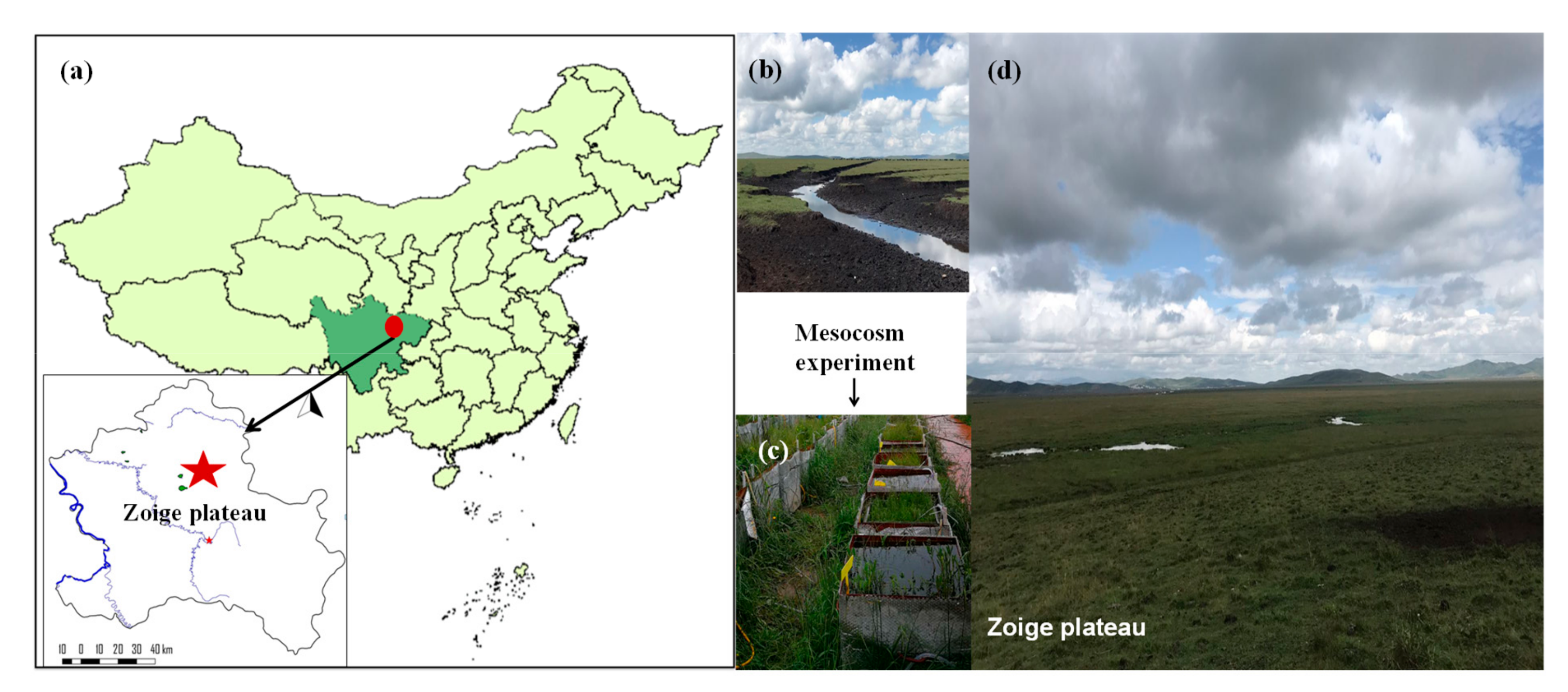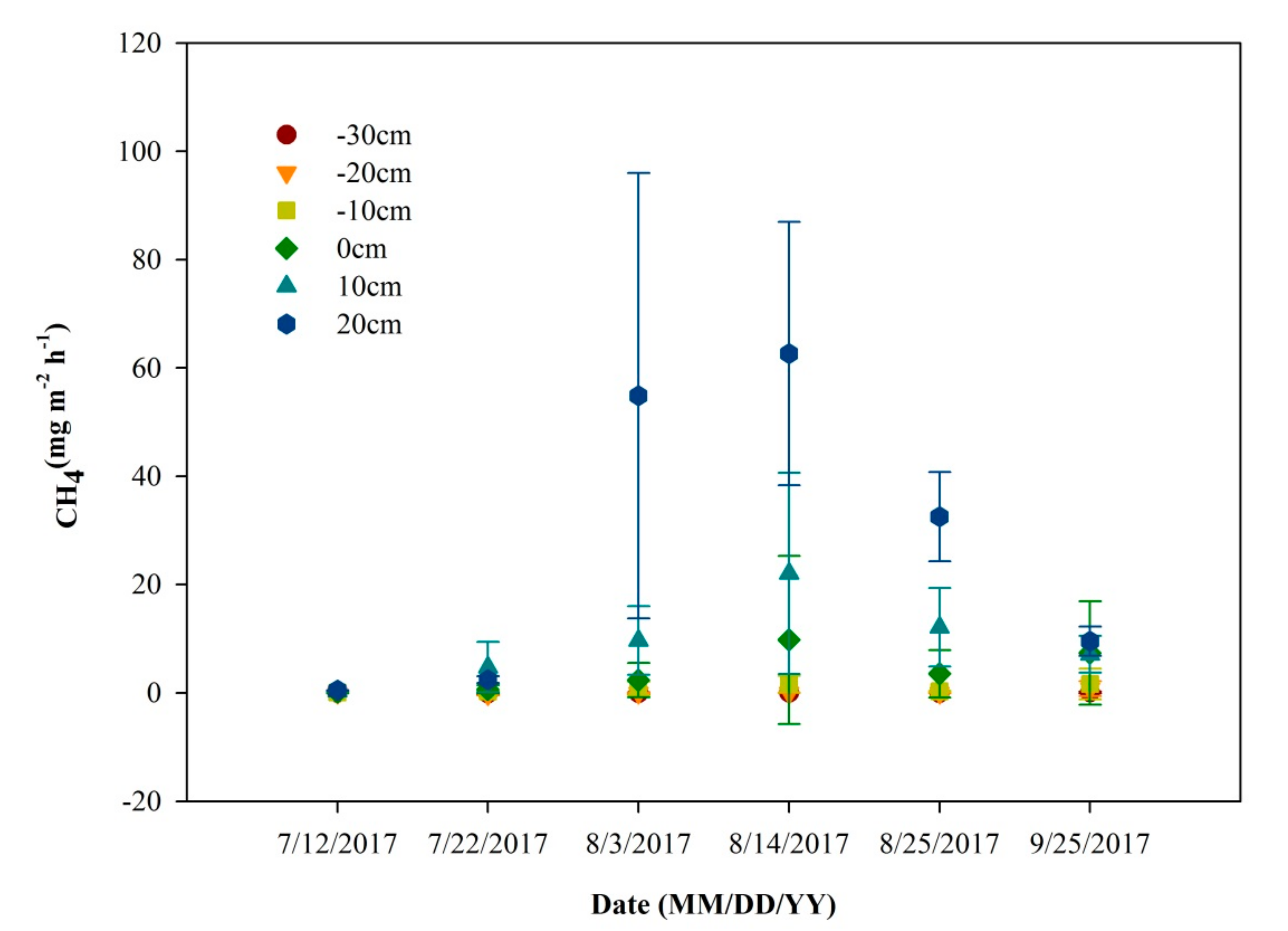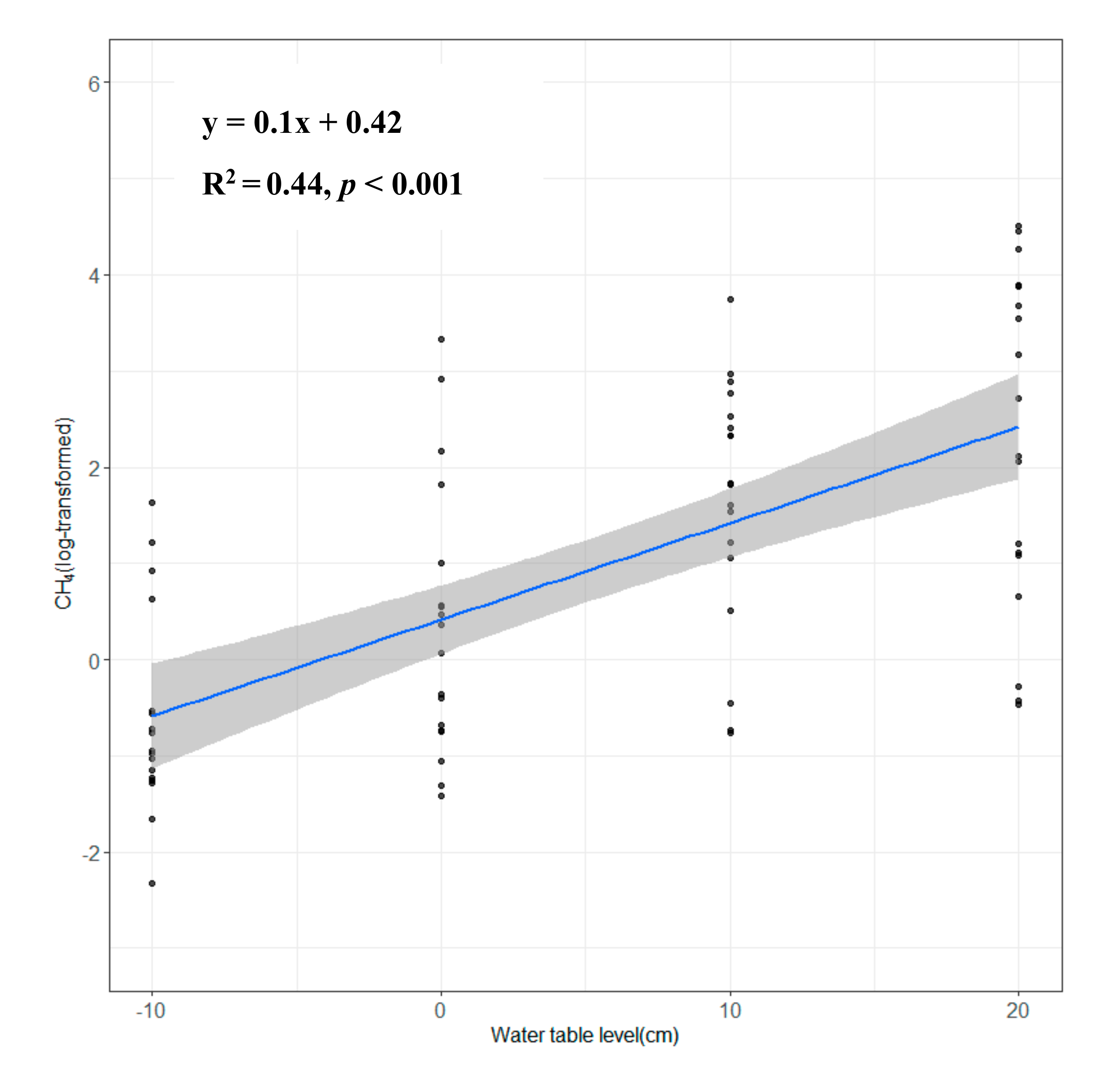Disproportionate Changes in the CH4 Emissions of Six Water Table Levels in an Alpine Peatland
Abstract
:1. Introduction
2. Experiments
2.1. Study Area
2.2. Experimental Design
2.3. CH4 Emissions and Environmental Measurements
2.4. Data Analysis
3. Results
3.1. Temporal Patterns of CH4 Emissions
3.2. Relationship between Water Table Level and CH4 Emissions
4. Discussion
4.1. Significant Effects of Water Table Level and Their Relationship with CH4 Emissions
4.2. Limitations and Suggestions
5. Conclusions
Author Contributions
Funding
Acknowledgments
Conflicts of Interest
References
- Hooijer, A. Current and future CO2 emissions from drained peatlands in Southeast Asia. Biogeosciences Discuss. 2009, 7, 1505–1514. [Google Scholar] [CrossRef] [Green Version]
- Xu, J.; Morris, P.J.; Liu, J.; Holden, J. PEATMAP: Refining estimates of global peatland distribution based on a meta-analysis. Catena 2018, 160, 134–140. [Google Scholar] [CrossRef] [Green Version]
- Mitsch, W.J.; Bernal, B.; Nahlik, A.M.; Mander, Ü.; Zhang, L.; Anderson, C.J.; Jørgensen, S.E.; Brix, H. Wetlands, carbon, and climate change. Landsc. Ecol. 2013, 28, 583–597. [Google Scholar] [CrossRef]
- Yuan, Y.; Yan, D.; Wang, H.; Wang, Q.; Weng, B. Quantitative assessment of drought in a lacustrine wetland based on a water balance model. Nat. Hazards 2014, 70, 693–703. [Google Scholar] [CrossRef]
- Zeng, X.; Gao, Y. Short-term effects of drying and rewetting on CO2 and CH4 emissions from high-altitude peatlands on the Tibetan Plateau. Atmosphere 2016, 7, 148. [Google Scholar] [CrossRef] [Green Version]
- Koffi, E.N.; Bergamaschi, P.; Alkama, R.; Cescatti, A. An observation-constrained assessment of the climate sensitivity and future trajectories of wetland methane emissions. Sci. Adv. 2020, 6, eaay4444. [Google Scholar] [CrossRef] [Green Version]
- Camacho, A.; Picazo, A.; Rochera, C.; Santamans, A.C.; Morant, D.; Miralles-Lorenzo, J.; Castillo-Escrivà, A. Methane Emissions in Spanish Saline Lakes: Current Rates, Temperature and Salinity Responses, and Evolution under Different Climate Change Scenarios. Water 2017, 9, 659. [Google Scholar] [CrossRef] [Green Version]
- Moore, T.R.; Knowles, R. The influence of water table levels on methane and carbon dioxide emissions from peatland soils. Can. J. Soil Sci. 1989, 69, 33–38. [Google Scholar] [CrossRef]
- Yrjälä, K.; Tuomivirta, T.; Juottonen, H.; Putkinen, A.; Lappi, K.; Tuittila, E.S.; Penttilä, T.; Minkkinen, K.; Laine, J.; Peltoniemi, K. CH4 production and oxidation processes in a boreal fen ecosystem after long-term water table drawdown. Glob. Chang. Biol. 2011, 17, 1311–1320. [Google Scholar] [CrossRef] [Green Version]
- Tiwari, S.; Singh, C.; Singh, J.S. Wetlands: A Major Natural Source Responsible for Methane Emission. In Restoration of Wetland Ecosystem: A Trajectory Towards a Sustainable Environment; Upadhyay, A.K., Singh, R., Singh, D.P., Eds.; Springer: Singapore, 2020; pp. 59–74. [Google Scholar] [CrossRef]
- Strack, M.; Waddington, J.M.; Tuittila, E.S. Effect of water table drawdown on northern peatland methane dynamics: Implications for climate change. Glob. Biogeochem. Cycles 2004, 18, 18. [Google Scholar] [CrossRef] [Green Version]
- Minkkinen, K.; Korhonen, R.; Savolainen, I.; Laine, J. Carbon balance and radiative forcing of Finnish peatlands 1900–2100–the impact of forestry drainage. Glob. Chang. Biol. 2002, 8, 785–799. [Google Scholar] [CrossRef]
- Turetsky, M.R.; Benscoter, B.; Page, S.; Rein, G.; Van Der Werf, G.R.; Watts, A. Global vulnerability of peatlands to fire and carbon loss. Nat. Geosci. 2015, 8, 11–14. [Google Scholar] [CrossRef]
- Zhang, X.; Liu, H.; Baker, C.; Graham, S. Restoration approaches used for degraded peatlands in Ruoergai (Zoige), Tibetan Plateau, China, for sustainable land management. Ecol. Eng. 2012, 38, 86–92. [Google Scholar] [CrossRef]
- Ellis, T.; Hill, P.; Fenner, N.; Williams, G.; Godbold, D.; Freeman, C. The interactive effects of elevated carbon dioxide and water table draw-down on carbon cycling in a Welsh ombrotrophic bog. Ecol. Eng. 2009, 35, 978–986. [Google Scholar] [CrossRef]
- Wang, H.; Yu, L.; Zhang, Z.; Liu, W.; Chen, L.; Cao, G.; Yue, H.; Zhou, J.; Yang, Y.; Tang, Y. Molecular mechanisms of water table lowering and nitrogen deposition in affecting greenhouse gas emissions from a Tibetan alpine wetland. Glob. Chang. Biol. 2017, 23, 815–829. [Google Scholar] [CrossRef] [Green Version]
- Yang, J.; Liu, J.; Hu, X.; Li, X.; Wang, Y.; Li, H. Effect of water table level on CO2, CH4 and N2O emissions in a freshwater marsh of Northeast China. Soil Biol. Biochem. 2013, 61, 52–60. [Google Scholar] [CrossRef]
- Järveoja, J.; Peichl, M.; Maddison, M.; Soosaar, K.; Vellak, K.; Karofeld, E.; Teemusk, A.; Mander, Ü. Impact of water table level on annual carbon and greenhouse gas balances of a restored peat extraction area. Biogeosciences 2016, 13, 2637. [Google Scholar] [CrossRef] [Green Version]
- Sundh, I.; Nilsson, M.; Granberg, G.; Svensson, B.H. Depth distribution of microbial production and oxidation of methane in northern boreal peatlands. Microb. Ecol. 1994, 27, 253–265. [Google Scholar] [CrossRef]
- Moore, T.R.; Roulet, N.T. Methane flux: Water table relations in northern wetlands. Geophys. Res. Lett. 1993, 20, 587–590. [Google Scholar] [CrossRef] [Green Version]
- Updegraff, K.; Bridgham, S.D.; Pastor, J.; Weishampel, P.; Harth, C. Response of CO2 and CH4 emissions from peatlands to warming and water table manipulation. Ecol. Appl. 2001, 11, 311–326. [Google Scholar] [CrossRef]
- Zona, D.; Oechel, W.C.; Kochendorfer, J.; Paw, U.K.T.; Salyuk, A.N.; Olivas, P.C.; Oberbauer, S.F.; Lipson, D.A. Methane fluxes during the initiation of a large-scale water table manipulation experiment in the Alaskan Arctic tundra. Glob. Biogeochem. Cycles 2009, 23. [Google Scholar] [CrossRef]
- Cui, L.; Kang, X.; Li, W.; Hao, Y.; Zhang, Y.; Wang, J.; Yan, L.; Zhang, X.; Zhang, M.; Zhou, J.; et al. Rewetting Decreases Carbon Emissions from the Zoige Alpine Peatland on the Tibetan Plateau. Sustainability 2017, 9, 948. [Google Scholar] [CrossRef] [Green Version]
- Zhou, W.; Cui, L.; Wang, Y.; Li, W.; Kang, X. Characteristics of methane emission fluxes in the Zoigê Plateau wetland on microtopography. Chin. J. Plant Ecol. 2016, 40, 902–911. [Google Scholar]
- Bretz, F.; Hothorn, T.; Westfall, P. Multiple Comparisons Using R; Chapman and Hall/CRC: New York, NY, USA, 2016. [Google Scholar] [CrossRef]
- Nakagawa, S.; Schielzeth, H. A general and simple method for obtaining R2 from generalized linear mixed-effects models. Methods Ecol. Evol. 2013, 4, 133–142. [Google Scholar] [CrossRef]
- Zhu, Y.; Purdy, K.J.; Eyice, Ö.; Shen, L.; Harpenslager, S.F.; Yvon-Durocher, G.; Dumbrell, A.J.; Trimmer, M. Disproportionate increase in freshwater methane emissions induced by experimental warming. Nat. Clim. Chang. 2020, 10, 685–690. [Google Scholar] [CrossRef]
- Kalyuzhnaya, M.G.; Gomez, O.A.; Murrell, J.C. The Methane-Oxidizing Bacteria (Methanotrophs). In Taxonomy, Genomics and Ecophysiology of Hydrocarbon-Degrading Microbes; McGenity, T.J., Ed.; Springer International Publishing: Cham, Switzerland, 2019; pp. 1–34. [Google Scholar] [CrossRef]
- Deshmukh, C.S.; Julius, D.; Evans, C.D.; Nardi; Susanto, A.P.; Page, S.E.; Gauci, V.; Laurén, A.; Sabiham, S.; Agus, F.; et al. Impact of forest plantation on methane emissions from tropical peatland. Glob. Chang. Biol. 2020, 26, 2477–2495. [Google Scholar] [CrossRef] [Green Version]
- Limpert, K.E.; Carnell, P.E.; Trevathan-Tackett, S.M.; Macreadie, P.I. Reducing Emissions From Degraded Floodplain Wetlands. Front. Environ. Sci. 2020, 8, 18. [Google Scholar] [CrossRef]
- Wang, D.-X.; Gao, Y.-H.; An, X.-J.; Wang, R.; Xie, Q.-Y. Responses of greenhouse gas emissions to water table fluctuations in an alpine wetland on the Qinghai-Tibetan Plateau. Acta Prataculturae Sin. 2016, 25, 27–35. [Google Scholar]
- Brown, M.G.; Humphreys, E.R.; Moore, T.R.; Roulet, N.T.; Lafleur, P.M. Evidence for a nonmonotonic relationship between ecosystem-scale peatland methane emissions and water table depth. J. Geophys. Res. Biogeosci. 2014, 119, 826–835. [Google Scholar] [CrossRef] [Green Version]
- Song, W.; Wang, H.; Wang, G.; Chen, L.; Jin, Z.; Zhuang, Q.; He, J.S. Methane emissions from an alpine wetland on the Tibetan Plateau: Neglected but vital contribution of the nongrowing season. J. Geophys. Res. Biogeosci. 2015, 120, 1475–1490. [Google Scholar] [CrossRef]
- Zhang, H.; Yao, Z.; Ma, L.; Zheng, X.; Wang, R.; Wang, K.; Liu, C.; Zhang, W.; Zhu, B.; Tang, X. Annual methane emissions from degraded alpine wetlands in the eastern Tibetan Plateau. Sci. Total Environ. 2019, 657, 1323–1333. [Google Scholar] [CrossRef] [PubMed]
- Zhong, Q.; Xue, D.; Chen, H.; Liu, L.; He, Y.; Zhu, D.; He, Z. Structure and distribution of nitrite-dependent anaerobic methane oxidation bacteria vary with water tables in Zoige peatlands. FEMS Microbiol. Ecol. 2020, 96. [Google Scholar] [CrossRef] [PubMed]
- Yang, G.; Tian, J.; Chen, H.; Jiang, L.; Zhan, W.; Hu, J.; Zhu, E.; Peng, C.; Zhu, Q.; Zhu, D.; et al. Peatland degradation reduces methanogens and methane emissions from surface to deep soils. Ecol. Indic. 2019, 106, 105488. [Google Scholar] [CrossRef]
- Wang, J.; Li, A.; Bian, J. Simulation of the grazing effects on grassland aboveground net primary production using DNDC model combined with time-series remote sensing data—A case study in Zoige Plateau, China. Remote Sens. 2016, 8, 168. [Google Scholar] [CrossRef] [Green Version]
- Boke-Olén, N.; Lehsten, V.; Abdi, A.M.; Ardö, J.; Khatir, A.A. Estimating Grazing Potentials in Sudan Using Daily Carbon Allocation in Dynamic Vegetation Model. Rangel. Ecol. Manag. 2018, 71, 792–797. [Google Scholar] [CrossRef]
- Thonicke, K.; Venevsky, S.; Sitch, S.; Cramer, W. The role of fire disturbance for global vegetation dynamics: Coupling fire into a Dynamic Global Vegetation Model. Glob. Ecol. Biogeogr. 2001, 10, 661–677. [Google Scholar] [CrossRef] [Green Version]
- Li, F.; Zeng, X.; Levis, S. A process-based fire parameterization of intermediate complexity in a Dynamic Global Vegetation Model. Biogeosciences 2012, 9. [Google Scholar] [CrossRef] [Green Version]




| Water Table Level | −30 cm | −20 cm | −10 cm | 0 cm | 10 cm | 20 cm |
|---|---|---|---|---|---|---|
| −30 cm | - | |||||
| −20 cm | 1 ns | - | ||||
| −10 cm | ns | ns | ||||
| 0 cm | 2 ** | ** | ns | |||
| 10 cm | 3 *** | *** | *** | ns | ||
| 20 cm | *** | *** | *** | *** | ns | - |
| Predictors | CH4 (Log-Transformed) | ||
|---|---|---|---|
| Estimates | CI | p | |
| Intercept | 0.42 | 0.00–0.83 | 0.04 |
| 1 WTL | 0.10 | 0.07–0.13 | <0.001 |
| 2 Marginal R2/3 Conditional R2 | 0.40/0.44 | ||
| Sites | Lat (°N) | Long (°) | WTL (cm) | Percent Changes in CH4 (%) | Reference |
|---|---|---|---|---|---|
| Migneint Valley, North Wales, UK | N.A. | N.A. | −5 cm | 29 | [15] |
| Duck Creek North, Australian | 35.50 S | 143.87 E | N.A | 38 | [30] |
| St. Charles-de-Bellechasse, Canada | 46.47 N | 70.17 W | N.A | 55 | [11] |
| Central Estonia | 58.53 N | 25.85 E | N.A. | 72 | [18] |
| Central Estonia | 58.53 N | 25.85 E | N.A. | 38 | [18] |
| Sanjiang plain, China | 47.58 N | 133.52 E | N.A | 75 | [17] |
| Zoige, China | 33.9 N | 102.6 E | −45 cm then recovery | 52 | [31] |
| Haibei, China | 37.58 N | 101.33 E | −20 cm | 57 | [16] |
| Our study | 33.9 N | 102.8 E | 20 cm to −30 cm | 100 |
Publisher’s Note: MDPI stays neutral with regard to jurisdictional claims in published maps and institutional affiliations. |
© 2020 by the authors. Licensee MDPI, Basel, Switzerland. This article is an open access article distributed under the terms and conditions of the Creative Commons Attribution (CC BY) license (http://creativecommons.org/licenses/by/4.0/).
Share and Cite
Yan, L.; Zhang, X.; Wu, H.; Kang, E.; Li, Y.; Wang, J.; Yan, Z.; Zhang, K.; Kang, X. Disproportionate Changes in the CH4 Emissions of Six Water Table Levels in an Alpine Peatland. Atmosphere 2020, 11, 1165. https://doi.org/10.3390/atmos11111165
Yan L, Zhang X, Wu H, Kang E, Li Y, Wang J, Yan Z, Zhang K, Kang X. Disproportionate Changes in the CH4 Emissions of Six Water Table Levels in an Alpine Peatland. Atmosphere. 2020; 11(11):1165. https://doi.org/10.3390/atmos11111165
Chicago/Turabian StyleYan, Liang, Xiaodong Zhang, Haidong Wu, Enze Kang, Yong Li, Jinzhi Wang, Zhongqing Yan, Kerou Zhang, and Xiaoming Kang. 2020. "Disproportionate Changes in the CH4 Emissions of Six Water Table Levels in an Alpine Peatland" Atmosphere 11, no. 11: 1165. https://doi.org/10.3390/atmos11111165
APA StyleYan, L., Zhang, X., Wu, H., Kang, E., Li, Y., Wang, J., Yan, Z., Zhang, K., & Kang, X. (2020). Disproportionate Changes in the CH4 Emissions of Six Water Table Levels in an Alpine Peatland. Atmosphere, 11(11), 1165. https://doi.org/10.3390/atmos11111165








